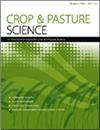白三叶草(T. repens)的祖先白三叶(Trifolium pallescens)和西三叶草(T. occidentale)对磷的响应
IF 1.9
4区 农林科学
Q2 AGRICULTURE, MULTIDISCIPLINARY
引用次数: 0
摘要
抽象的上下文。磷矿储量正在减少,减轻农业土壤中磷含量过高对环境影响的需求正在增加。目标白三叶草是白三叶草和西方三叶草的异源四倍体杂种。了解这些祖先种对磷的响应特性,将有助于选育具有更高磷利用效率的合成白三叶草种质。方法。在低磷土壤中施用5种磷,比较了3株淡三叶草、6株西洋三叶草和1株白三叶草的地上部和根系质量及磷营养特性。白三叶草对磷的响应最高,根系干重(DW)响应最大,而白三叶草对磷的响应最小。在高磷处理下,白三叶草的茎部和根系P %最高,茎部DW:植株全磷比最低。各祖系间差异显著。西洋草西班牙供种的茎部重与白三叶相当,PUE较高。白三叶草的性状表现出较强的低磷适应性,而西三叶草的性状则更接近于白三叶草品种。结论。白三叶草祖先种间磷营养特性的显著差异可在育种规划中加以利用。的影响。比较不同祖先品种对磷的响应,可以为培育合成白三叶草提供参考,提高白三叶草对低磷土壤的耐受性。本文章由计算机程序翻译,如有差异,请以英文原文为准。
Phosphorus responses of Trifolium pallescens and T. occidentale, the progenitors of white clover (T. repens)
ABSTRACT Context. Rock phosphate reserves are decreasing, and requirements to mitigate environmental impacts of farming soils with excess phosphorus (P) are increasing. Aims. White clover is an allotetraploid hybrid between Trifolium pallescens and T. occidentale. Understanding the P response characteristics of these progenitor species will allow selection of germplasm for development of synthetic white clovers with improved phosphorus-use efficiency (PUE). Methods. Shoot and root weights and P nutrition characteristics were compared for three Trifolium pallescens, six T. occidentale accessions, and a white clover cultivar in a glasshouse experiment using a low P soil amended with five rates of P. Key results. White clover had the highest and most P responsive shoot and root dry weights (DW), and T. pallescens was least responsive to P. In the highest P treatment, T. pallescens had the highest shoot and root %P and the lowest shoot DW:total plant P ratio. There was significant variation among progenitor accessions. Spanish accessions of T. occidentale had comparable shoot DW to white clover and higher PUE. Traits of T. pallescens indicated strong adaptation to low P but low productivity, while traits of T. occidentale were more aligned with the white clover cultivar. Conclusions. The substantial variation in P nutrition characteristics within the progenitor species of white clover could be exploited in breeding programs. Implications. Comparing the P responses of a wider range of progenitor accessions could inform breeding to improve white clover’s low soil P tolerance through development of synthetic white clovers.
求助全文
通过发布文献求助,成功后即可免费获取论文全文。
去求助
来源期刊

Crop & Pasture Science
AGRICULTURE, MULTIDISCIPLINARY-
CiteScore
4.20
自引率
15.80%
发文量
111
审稿时长
3 months
期刊介绍:
Crop and Pasture Science (formerly known as Australian Journal of Agricultural Research) is an international journal publishing outcomes of strategic research in crop and pasture sciences and the sustainability of farming systems. The primary focus is broad-scale cereals, grain legumes, oilseeds and pastures. Articles are encouraged that advance understanding in plant-based agricultural systems through the use of well-defined and original aims designed to test a hypothesis, innovative and rigorous experimental design, and strong interpretation. The journal embraces experimental approaches from molecular level to whole systems, and the research must present novel findings and progress the science of agriculture.
Crop and Pasture Science is read by agricultural scientists and plant biologists, industry, administrators, policy-makers, and others with an interest in the challenges and opportunities facing world agricultural production.
Crop and Pasture Science is published with the endorsement of the Commonwealth Scientific and Industrial Research Organisation (CSIRO) and the Australian Academy of Science.
 求助内容:
求助内容: 应助结果提醒方式:
应助结果提醒方式:


